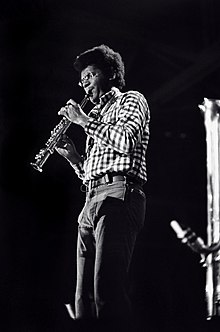After All Is Said
| After All Is Said | ||||
|---|---|---|---|---|
| Studio album by Tomas Fujiwara & The Hook Up | ||||
|
Publication |
||||
| Label (s) | 482 Music | |||
|
Format (s) |
CD |
|||
|
Title (number) |
7th |
|||
|
running time |
56:47 |
|||
| occupation |
|
|||
|
||||
After All Is Said is a jazz album by Tomas Fujiwara & The Hook Up. The recordings made in 2014 were released on 482 Music in 2015 .
background
After Actionspeak (2011) and The Air Is Different (2012), After All is Said was the third album by Tomas Fujiwara & the Hook Up. Although the basic line-up of the group remained fairly stable, Michael Formanek took over the post of bassist previously held by Trevor Dunn and Danton Boller , joining Fujiwara and founding members Brian Settles (tenor saxophone), Jonathan Finlayson (trumpet) and Mary Halvorson (guitar ) on. In addition to the recruitment of Formanek, the group's instrumental palette has been expanded slightly; Settles played the flute for the first time in a hook-up session and introduced the cinematic opening number “Lastly” with Asian flourishes.
Track list
- Tomas Fujiwara & The Hook Up: After All Is Said (482 Music 482-1089)
- Lastly 7:58
- The Comb 7:59
- For Tom and Gerald 2:04
- Boaster's Roast 10:19
- Solar wind 11:02
- The Hook Up 7:21
- When 10:02
- All compositions are by Tomas Fujiwara.
reception
According to Troy Collins, who reviewed the album in All About Jazz and awarded it 4½ stars, Fujiwara's non-linear compositions usually avoid traditional song structures such as "The Comb". "The Rubato piece interrupts a bold pointillist dialogue between tenor, guitar and drums with a dark interlude for sad trumpet and bowed bass and gradually transforms into a quixotic collage of lively articulated phrases and lazy refrains, which are set in several time signatures." "Boaster's Roast" juxtaposes the rocking backbeats of the muscular rhythm section and Halvorson's spiky guitar contributions against nervous, wind-driven funk , while "For Tom and Gerald" summarizes the tasteful art of the leader with a muted but convincing unaccompanied drum solo without any showmanship , noted Collins.
The author also shows Formanek's imposing presence; his majestically executed pizzicato solo is the climax of “Solar Wind” after an exciting opening duet between Fujiwara and Settles and an extended passage of dazzling rhythmic inventions by Finlayson. The swinging title track demonstrates the traditional jazz skills of the band members in a succinct series of virtuoso solos. According to the author, the album is "one of the most accessible, challenging and inventive recordings of the last year".
Also in All About Jazz, Glenn Astarita wrote that Tomas Fujiwara's The Hook Up presents artists who were among the most prominent exponents of new directions in jazz and improvisation. Here the bandleader acts “as an instigator and driving factor through his rhythmically formed works, which consist of rolling, tumbling and splintered movements that are shaped by burgeoning thematic developments.” Fujiwara supported the band in “Solar Wind” by creating grooves that based on polyrhythmic patterns with lyrical implications.
According to the Avant Music News reviewer, Anthony Braxton's influence shines brightly in Fujiwara's composing - " After All is Said clearly recites jazz, but with tight, complex texture, staggered rhythms and excellent execution. This is a very strong publication, ”wrote the author.
Chris Haines wrote on the Free Jazz Blog that After All Is Said starts with a free falling melody line from the flute against a syncopated bass and drum rhythm and some percussive, delayed effects from the guitar. Only this small sound sample captures the intention of the album, whereby the different colors of the varied instrumentation not only alternately come to the fore, but also provide a rhythmic and multicolored background for the happening as the music develops over time, wrote Haines. "The saxophone and trumpet of Settles and Finlayson go well together, sometimes playing in unison lines that create a sharp and angular counterpoint to Halvorson's guitar, which is driven by Fujiwara's funky beats on the track 'Boaster's Roast' ." On After All Is Said has a real feeling of group cohesion, the author sums up, "and as a work it sits pretty firmly on the ear with some complicated individual parts that fit well into this close-knit unit."
Web links
Individual evidence
- ^ A b Troy Collins: Tomas Fujiwara & The Hook Up: After All is Said. All About Jazz, April 29, 2015, accessed June 7, 2020 .
- ↑ Tomas Fujiwara & The Hook Up: After All is Said. All About Jazz, April 27, 2019, accessed June 7, 2020 .
- ↑ Tomas Fujiwara & The Hook Up: After All is Said. Avant Music News, July 24, 2015, accessed May 7, 2020 .
- ↑ Chris Haines: Tomas Fujiwara & The Hook Up: After All is Said. Free Jazz Blog, July 24, 2015, accessed June 7, 2020 .

